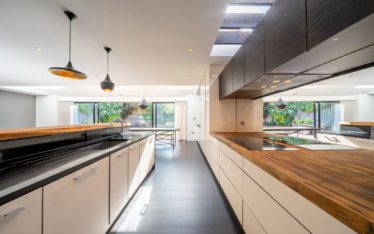Whether you’re looking to renovate an existing property or build up from a plot of land, there are some renovations that require important planning permission from your council. If you decide on a living room extension or a loft conversion, this may affect the space and privacy of your neighbours. Therefore, planning permission is needed as otherwise, everyone would build on top of one another!
Obtaining planning permission could be a crucial step to ensuring the project runs smoothly. If you undertake work that needs planning permission and you skip this step, there is a risk of being served an enforcement notice. This means you may have to undo all the work that has already been completed. Whatever plans you have, here is a step-by-step guide on how to get planning permission, as well as how to keep everyone happy along the way.
Seek Pre-Application Advice
You will find your local council provides pre-application advice regarding planning permission. This will come at a fee, but getting feedback on what you can and cannot get planning permission for can help you know what steps to take next. There may be changes you want to make during the process too. Make sure you listen to their advice and ask any questions you may have. This step is invaluable and is highly advised for a successful and straightforward planning permission application.
Your local council will have helped thousands of people in the same boat as you. Before seeking advice, make sure you have all your plans cemented and laid out for them to see. This will ensure you get the right support and know what actions to take next.
Work With a Planning Officer
Try not to see your planning officer as a hindrance. They’re there to help and listen to you, not go against you. If they recommend any changes to your plans, don’t take this personally. Your planning officer will want to do everything they can to help you secure planning permission.
During the submission process, your planning officer should know the ins and outs of your project. If they make any suggestions, take them on board, rather than not listening to their advice. When you make minor alterations, this could be the difference between a successful planning permission application, and it being thrown out the window.
Hire a Local Architect
An experienced local architect can help navigate the planning process for you. One part of this is getting the design right for approval. Whether you want to add a new bathroom, convert your loft, or add an extension, they will have tons of experience working with the local planning authority. This means they’ll be comfortable with designs that are sure to be approved.
Architects also have knowledge in applying for planning permission and will make sure you’ve got all the necessary paperwork in place. Your architect will use their expertise to design a project that has the best chance of approval, as well as help you get the most out of your space.
Think About Your Design
If your number one goal is to get planning permission approval, you need to ensure your design is in-keeping and will enhance your local area, rather than being left with something that’s obtrusive. There are lots of things to think about regarding your design, such as wildlife in the area. For instance, if you’re planning a loft conversion, there are protected species like bats that may be lurking up there. Now may be the time to get a bat emergence survey conducted from Arbtech. They can identify if there is evidence of bat activity and what steps to take further.
Your local planning authority will make a decision on planning permission based on the impact on surrounding areas, as well as the density and layout of the buildings (like roof height). Other factors include appearance and what materials are used.
Talk to Your Neighbours
For a smooth and seamless planning permission application, it’s wise to chat to your neighbours sooner rather than later. Talk to them before they receive the letter from the council outlining your plans. Even if you don’t know them well, it’s always a good idea to give them a heads up. Doing so will keep them on side and minimise the risk of anything going wrong. You should go into detail about your plans and make alterations before planning permission if you believe they’re reasonable requests.
While it’s the planning committee that has the final say on planning, your neighbours’ concerns, and comments will also be taken into consideration. Should they not be happy with proceedings to go forward, the planning committee may put a halt to your plans.
Be Patient
It must be noted that if you believe the planning permission process happens overnight, it’s time to be realistic. At best, it can take between 8 and 10 weeks to get approval. And this is only if no alterations are needed.
There may be planning conditions you’ll face if your project is signed off. These conditions are requirements you must fulfil before you get to work. For example, you may have to provide details on what building materials you use. In a nutshell, you need to be patient about the whole thing. There’s no point getting yourself worked up over something you cannot control. As long as you follow the guidance listed, this should ensure you have a speedy and successful application.
Securing planning permission can be one of the tensest moments of your project. The number one question on your mind will be whether you’ll get approval or not. If you have your heart set on renovation work and you need planning permission, make sure you follow the guide above to avoid any problems later down the line.
If you don’t get the outcome you want, the last thing you should do is start work regardless. Whatever renovations you have in mind, they will take up a lot of time and can cost a fortune. Therefore, getting the all clear before going ahead is key.





